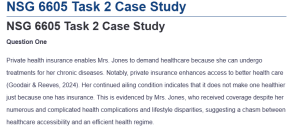NSG 6605 Task 2 Case Study
Question One
Private health insurance enables Mrs. Jones to demand healthcare because she can undergo treatments for her chronic diseases. Notably, private insurance enhances access to better health care (Goodair & Reeves, 2024). Her continued ailing condition indicates that it does not make one healthier just because one has insurance. This is evidenced by Mrs. Jones, who received coverage despite her numerous and complicated health complications and lifestyle disparities, suggesting a chasm between healthcare accessibility and an efficient health regime.
Question Two
Biological and genetic factors like obesity, asthma, hypertension, diabetes, depression, and her past smoking impact Mrs. Jones’ health. Her individual behaviors include difficulty in exercise, which leads to her chronic ailments. From this context, social factors that explained her employment status, job insecurity, physical environment as she lives in a suburban area, and health service access through private insurance all contributed to her overall health and care.
Question Three
Mrs. Jones’ at 55 years old, belongs to Generation X. This generation poses a unique requirement for the type of healthcare delivery that is convenient and based on information technology such as telemedicine and mobile health applications because most of them are balancing careers and family responsibilities. Also, due to an increased prevalence of chronic illness, including obesity, diabetes, and hypertension, Gen Xers need care coordination programs for proactive care and the effective and efficient management of multiple interrelated chronic conditions.
Question Four
A PPO economist who uses QALY (Quality-Adjusted Life Year) would assess the value of the PPO’s ‘Reaching for Better Health’ Program by ascertaining how far the program enhanced both the quality and longevity of Mrs. Jones’ life. They would examine whether the program aids in the management of her chronic conditions and, therefore, improves her health conditions and reduces her lost working days. It would be considered cost-effective if the program enhances her overall well-being and reduces healthcare costs.
References
Goodair, B., & Reeves, A. (2024). The effect of health-care privatisation on the quality of care. The Lancet. Public Health, 9(3), e199–e206. https://doi.org/10.1016/S2468-2667(24)00003-3
ORDER A PLAGIARISM-FREE PAPER HERE
We’ll write everything from scratch
Question
Units 4, 5, 6
Directions: Read the case study below and in your initial post (not to exceed 500 words) to the discussion board, answer the questions you find at the end of the case study. Include at least one reference to support your answers. This reference may be the course textbook.
In your cross-post (not to exceed 250 words) to a peer, address one of the case study answers from the peer’s initial post and support your response with at least one current (2019-2024), peer-reviewed, scholarly source (not your text).
Case Study: Sharon Jones, a 55 year old woman, visits her primary care physician. Her physician, Dr. Smith, is part of a preferred provider organization (PPO). Mrs. Jones is married, employed, and has healthcare insurance through her employer. She holds a master’s degree in business administration (MBA). Her yearly income is $80,000/year and she and her husband own a house in a suburb of Chicago. Mrs. Jones is a former smoker and has trouble finding the time to exercise.
Her ongoing health concerns include obesity, asthma, hypertension, Type II diabetes, and depression. Her supervisor has noted that Mrs. Jones has had increasing days absent from her job related to her health challenges. Mrs. Jones is worried that she may lose her job and health insurance if she continues to miss days of work.
Dr. Smith is aware of her complex medical issues and that her patient’s health status and quality of life is not as high as it might be. Dr. Smith tells Mrs. Jones about a new program that the PPO offers for patients ages 50-70, who experience multiple chronic illnesses. “Reaching for Better Health” provides ongoing group-setting education classes, health technology applications for Smartphones, and lifestyle classes for participants. Mrs. Jones likes this idea, enrolls in “Reaching for Better Health” for a 6-week period, and agrees to see Dr. Smith again after the 6 weeks have passed.

NSG 6605 Task 2 Case Study
Questions:
- What do we know about Mrs. Jones’ demand for healthcare as it relates to her private health insurance? Is there an evidence-based relationship between her private insurance plan and her level of health? Explain this relationship using Mrs. Jones as an example.
- Describe Mrs. Jones’ health using the five determinants of health discussed in Henderson.
- Identify Mrs. Jones’ generation based on her age. What unique demands is this generation placing on the healthcare system?
- How would economists who use QALY analysis evaluate the effectiveness of the PPO’s program, “Reaching for Better Health” (described above)?

